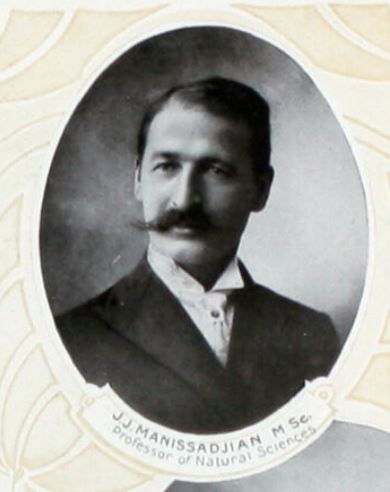J. J. Manissadijan on:
[Wikipedia]
[Google]
[Amazon]
J. J. Manissadjian (1862–1942) was a botanist who lived in the Ottoman Empire. After the collapse of the Ottoman Empire, he emigrated to the United States.


Life
Manissadjian mother, Katharina "Katherine" Margarete Barbara Klein, was German and his father, Barsam J Manissadjian, was Armenian. He studied natural history at the Humboldt University at Berlin. In 1890, he became ''Professor of Botany'' at the American Anatolia College inMarsovan
Merzifon ( hy, Մարզուան, Marzvan, Middle Persian: ; grc, Μερσυφὼν, Mersyphòn, el, Μερζιφούντα, Merzifounta) is a town and district in Amasya Province in the central Black Sea region of Turkey. It covers an area of , ...
(also spelled Mersiwan) in Paphlagonia in Northeastern Anatolia, where he founded a museum.
Manissadijan collected plants from the Southern Black Sea region, where he discovered several new species of bulbous plants that were later published by the Austrian Botanist Josef Franz Freyn
Josef Franz Freyn (7 December 1845, Prague – 16 January 1903, Prague-Smíchov) was an Austrian civil engineer and botanist.
He was the son of the Austrian forester Josef Freyn from Obecnic. In 1856-1862 he attended the ''Oberrealschule'' in Pra ...
.
In 1893, he wrote ''Lehrbücher des Seminars für Orientalische Sprachen zu Berlin Band 11: Mürsid-i lisan-y 'Osmani. Lehrbuch der modernen osmanischen Sprache'', it has been reprinted many times.
By 1894, he had supplied commercial gardeners in the Netherland, foremost ''Van Tubergen'', with plant material from the Pontus region. Among those were bulbs of the now locally extinct Sprenger's tulip from the Amasya region, and '' Allium tubergeni'' Freyn.
He sold other rare plants, for example ''Iris gatesii
''Iris gatesii'' is a species in the genus '' Iris'', it is also in the subgenus '' Iris'' and in the section ''Oncocyclus''. It is a rhizomatous perennial, from the mountains of Turkey and Iraq. It has long, narrow, grey-green or glaucous leav ...
'' to Dutch commercial gardeners. Too many bulbs of Tulipa sprengeri were taken from the wild, and the plant became extinct.
The museum-library of Merzifon was constructed between 1910 and 1911.
Manissadjian survived the Armenian genocide (between 1915 and 1918) during the First World War, as his mother was German, but he was arrested in late June 1915, and was imprisoned by Ottoman forces.
Manissadjian and his family were released after American missionaries (from the college) bribed the local gendarmes. They were relocated to Amasya to an agricultural unit which was managed by Germans. In 1917, he was allowed to explore and started creating a collection of specimens for the college. It ranged from shells, corals, minerals, plants to mammals and birds. Manissadjian's collection was illustrated in the ''Catalogue of the Museum of Anatolia College'' which was handwritten
Handwriting is the writing done with a writing instrument, such as a pen or pencil, in the hand. Handwriting includes both printing and cursive styles and is separate from formal calligraphy or typeface. Because each person's handwriting is u ...
by Manissadjian. It contained roughly 7,000 specimens.
In 1924, the college closed in Merzifon and reopened in Thessaloniki, Greece as Anatolia College. The college museum closed in 1939, and 130 of Manissadjian's plants went sent to the Herbarium of Ankara University
Ankara University ( tr, Ankara Üniversitesi) is a public university in Ankara, the capital city of Turkey. It was the first higher education institution founded in Turkey after the formation of the republic in 1923.
The university has 40 vocat ...
, Faculty of Science.
Manissadjian was married to Arousyag Sara Eunice Daglian (1868–1948).. He eventually fled to Detroit, USA, where he died in 1942.
Species
Species named after Manissadijan include: * '' Colchicum manissadjianii '' (Azn.) K.Perss. * ''Iris manissadijani'' Freyn, now a synonym ofIris sari
''Iris sari'' is a species in the genus '' Iris'', it is also in the subgenus '' Iris'' and in section ''Oncocyclus''. It is from the rocky steppes and hills of Turkey. It has curved or straight leaves, cream, greenish or yellowish flowers which ...
* '' Merenda manissadijani''
References
Other sources
* Brian Mathew, Turhan Baytop 1984. The bulbous Plants of Turkey. London, Batsford, p. 12. * Josef Franz Freyn 1894. Plantae novae Orientales. Österreichische botanische Zeitschrift, 324–327. * A Portrait of Manissadijan was published in Brian Mathew, Turhan Baytop 1984. The bulbous Plants of Turkey. London, Batsford, Pl. 12. {{DEFAULTSORT:Manissadijan, J. J. 19th-century botanists 1862 births 1942 deaths Humboldt University of Berlin alumni Scientists from the Ottoman Empire Emigrants from the Ottoman Empire to the United States Immigrants to the United States